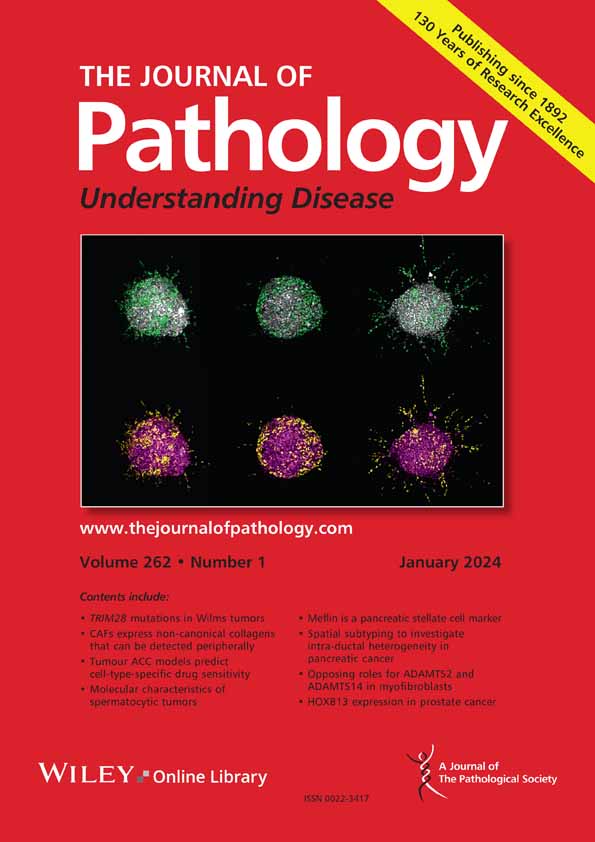Masafumi Horie, Hiroshi Takumida, Hayato Koba, Tsukasa Ueda, Hidenori Tanaka, Masami Suzuki, Yukinobu Ito, Ayumi Ito, Mao Kondo, Hiroshi I Suzuki, Isao Matsumoto, Seiji Yano, Akira Saito, Daichi Maeda
下载PDF
{"title":"特征miRNA谱代表了小细胞肺癌的临床病理多样性。","authors":"Masafumi Horie, Hiroshi Takumida, Hayato Koba, Tsukasa Ueda, Hidenori Tanaka, Masami Suzuki, Yukinobu Ito, Ayumi Ito, Mao Kondo, Hiroshi I Suzuki, Isao Matsumoto, Seiji Yano, Akira Saito, Daichi Maeda","doi":"10.1002/path.6458","DOIUrl":null,"url":null,"abstract":"<p>Small cell lung cancer (SCLC) is classified into distinct molecular subtypes based on the expression patterns of four transcription regulators: achaete–scute homolog 1 (ASCL1), neuronal differentiation 1 (NEUROD1), POU class 2 homeobox 3 (POU2F3), and yes-associated protein 1 (YAP1). MicroRNAs (miRNAs) play critical roles in cancer cellular processes but their subtype-specific implications in SCLC remain underexplored. Out of 46 surgically resected SCLC samples, miRNA visualization through <i>in situ</i> hybridization identified high expression of miR-375 in the ASCL1, NEUROD1, and ASCL1/NEUROD1 subtypes, and miR-9-5p in the POU2F3 subtype. Comprehensive enhancer profiling using SCLC cell lines indicated that miR-375 and miR-9-5p were regulated by super-enhancers in a subtype-specific manner. Multiplex immunohistochemistry by imaging mass cytometry found that the miR-9-5p-high SCLC was characterized by a higher stromal area ratio, increased numbers of CD8<sup>+</sup> T cells and CD163<sup>−</sup> macrophages in the intra-tumoral area, and an increased number of plasma cells in the stromal area, as compared with the miR-9-5p-low SCLC. Finally, clinicopathological analysis revealed that the miR-375-high SCLC was associated with YAP1 downregulation, increased serum pro-gastrin-releasing peptide levels, and poor prognosis. These findings highlight the critical role of super-enhancer-related miRNAs in the diversity of SCLC, and underscore the potential for novel diagnostic and prognostic biomarkers based on these subtype-specific miRNAs. © 2025 The Author(s). <i>The Journal of Pathology</i> published by John Wiley & Sons Ltd on behalf of The Pathological Society of Great Britain and Ireland.</p>","PeriodicalId":232,"journal":{"name":"The Journal of Pathology","volume":"267 2","pages":"168-180"},"PeriodicalIF":5.2000,"publicationDate":"2025-08-22","publicationTypes":"Journal Article","fieldsOfStudy":null,"isOpenAccess":false,"openAccessPdf":"https://www.ncbi.nlm.nih.gov/pmc/articles/PMC12438024/pdf/","citationCount":"0","resultStr":"{\"title\":\"Characteristic miRNA profiles represent clinicopathological diversity of small cell lung cancer\",\"authors\":\"Masafumi Horie, Hiroshi Takumida, Hayato Koba, Tsukasa Ueda, Hidenori Tanaka, Masami Suzuki, Yukinobu Ito, Ayumi Ito, Mao Kondo, Hiroshi I Suzuki, Isao Matsumoto, Seiji Yano, Akira Saito, Daichi Maeda\",\"doi\":\"10.1002/path.6458\",\"DOIUrl\":null,\"url\":null,\"abstract\":\"<p>Small cell lung cancer (SCLC) is classified into distinct molecular subtypes based on the expression patterns of four transcription regulators: achaete–scute homolog 1 (ASCL1), neuronal differentiation 1 (NEUROD1), POU class 2 homeobox 3 (POU2F3), and yes-associated protein 1 (YAP1). MicroRNAs (miRNAs) play critical roles in cancer cellular processes but their subtype-specific implications in SCLC remain underexplored. Out of 46 surgically resected SCLC samples, miRNA visualization through <i>in situ</i> hybridization identified high expression of miR-375 in the ASCL1, NEUROD1, and ASCL1/NEUROD1 subtypes, and miR-9-5p in the POU2F3 subtype. Comprehensive enhancer profiling using SCLC cell lines indicated that miR-375 and miR-9-5p were regulated by super-enhancers in a subtype-specific manner. Multiplex immunohistochemistry by imaging mass cytometry found that the miR-9-5p-high SCLC was characterized by a higher stromal area ratio, increased numbers of CD8<sup>+</sup> T cells and CD163<sup>−</sup> macrophages in the intra-tumoral area, and an increased number of plasma cells in the stromal area, as compared with the miR-9-5p-low SCLC. Finally, clinicopathological analysis revealed that the miR-375-high SCLC was associated with YAP1 downregulation, increased serum pro-gastrin-releasing peptide levels, and poor prognosis. These findings highlight the critical role of super-enhancer-related miRNAs in the diversity of SCLC, and underscore the potential for novel diagnostic and prognostic biomarkers based on these subtype-specific miRNAs. © 2025 The Author(s). <i>The Journal of Pathology</i> published by John Wiley & Sons Ltd on behalf of The Pathological Society of Great Britain and Ireland.</p>\",\"PeriodicalId\":232,\"journal\":{\"name\":\"The Journal of Pathology\",\"volume\":\"267 2\",\"pages\":\"168-180\"},\"PeriodicalIF\":5.2000,\"publicationDate\":\"2025-08-22\",\"publicationTypes\":\"Journal Article\",\"fieldsOfStudy\":null,\"isOpenAccess\":false,\"openAccessPdf\":\"https://www.ncbi.nlm.nih.gov/pmc/articles/PMC12438024/pdf/\",\"citationCount\":\"0\",\"resultStr\":null,\"platform\":\"Semanticscholar\",\"paperid\":null,\"PeriodicalName\":\"The Journal of Pathology\",\"FirstCategoryId\":\"3\",\"ListUrlMain\":\"https://pathsocjournals.onlinelibrary.wiley.com/doi/10.1002/path.6458\",\"RegionNum\":2,\"RegionCategory\":\"医学\",\"ArticlePicture\":[],\"TitleCN\":null,\"AbstractTextCN\":null,\"PMCID\":null,\"EPubDate\":\"\",\"PubModel\":\"\",\"JCR\":\"Q1\",\"JCRName\":\"ONCOLOGY\",\"Score\":null,\"Total\":0}","platform":"Semanticscholar","paperid":null,"PeriodicalName":"The Journal of Pathology","FirstCategoryId":"3","ListUrlMain":"https://pathsocjournals.onlinelibrary.wiley.com/doi/10.1002/path.6458","RegionNum":2,"RegionCategory":"医学","ArticlePicture":[],"TitleCN":null,"AbstractTextCN":null,"PMCID":null,"EPubDate":"","PubModel":"","JCR":"Q1","JCRName":"ONCOLOGY","Score":null,"Total":0}
引用次数: 0
引用
批量引用





 求助内容:
求助内容: 应助结果提醒方式:
应助结果提醒方式:


